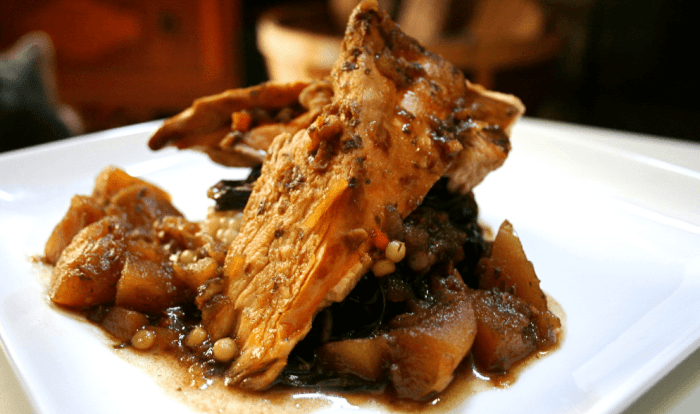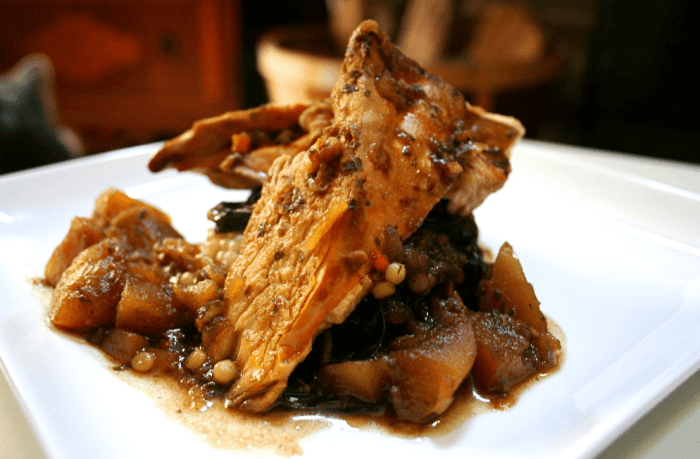
Chicken of the woods recipe, a culinary delight that beckons us to explore the depths of the forest and unlock the hidden treasures it holds. This vibrant fungus, with its striking colors and delectable flavor, offers a versatile canvas for culinary creations that will tantalize your taste buds.
From hearty soups and stews to savory stir-fries and delectable entrees, chicken of the woods recipe invites you on a gastronomic adventure where nature’s bounty meets culinary artistry.
Culinary Versatility of Chicken of the Woods
Chicken of the woods is not only delicious, but also incredibly versatile in the kitchen. Its meaty texture and mild flavor make it a great addition to a wide variety of dishes, from stir-fries to soups and stews.
If you’re looking for a unique and delicious vegetarian dish, check out this chicken of the woods recipe . This edible mushroom has a meaty texture and a savory flavor that makes it a great substitute for chicken in many recipes.
One of the most popular ways to cook chicken of the woods is to stir-fry it. The mushrooms can be cut into strips or chunks and cooked with other vegetables, such as onions, peppers, and broccoli. Chicken of the woods can also be added to soups and stews.
Its meaty texture and flavor will add depth and richness to any dish.
Soups and Stews
- Creamy chicken of the woods soup
- Chicken of the woods and wild rice soup
- Chicken of the woods and vegetable stew
Identifying and Harvesting Chicken of the Woods: Chicken Of The Woods Recipe
Chicken of the woods is a vibrant fungus that is prized for its meaty texture and delicate flavor. Identifying and harvesting this mushroom responsibly is crucial for a successful foraging experience.
Chicken of the woods is characterized by its bright orange to yellow color and shelf-like appearance. It typically grows in clusters on the trunks or stumps of deciduous trees, particularly oaks and maples. The mushroom has a firm, meaty texture and a mild, slightly fruity flavor.
Harvesting Responsibly
When harvesting chicken of the woods, it is important to do so sustainably. Always identify the mushroom accurately before consuming it, and only harvest from healthy specimens. Cut the mushroom at the base of the stem, leaving the root intact to allow for future growth.
Harvest only what you need, and leave plenty for other foragers and wildlife.
Nutritional Benefits of Chicken of the Woods

Chicken of the woods is a nutritionally rich mushroom that offers a variety of health benefits. It is a good source of protein, fiber, and antioxidants.
Chicken of the woods contains about 20% protein, which is higher than most other edible mushrooms. It is also a good source of fiber, with about 10% of its dry weight being composed of dietary fiber. Fiber is important for digestive health and can help to lower cholesterol levels.
Antioxidants, Chicken of the woods recipe
Chicken of the woods is also a good source of antioxidants, which are compounds that can help to protect the body from damage caused by free radicals. Free radicals are unstable molecules that can damage cells and DNA, and have been linked to a number of chronic diseases, including cancer and heart disease.
Preserving and Storing Chicken of the Woods
To extend the shelf life of your chicken of the woods, consider these preservation and storage methods:
Drying: Drying is an excellent method to preserve chicken of the woods for extended periods. Slice the mushrooms thinly and dehydrate them in a food dehydrator or oven at a low temperature (around 115°F or 46°C) until they become crispy and brittle.
Store the dried mushrooms in an airtight container in a cool, dry place for up to 6 months.
Freezing: Freezing is another effective way to preserve chicken of the woods. Clean and slice the mushrooms, then blanch them in boiling water for 2-3 minutes to inactivate enzymes that can cause spoilage. Drain the mushrooms thoroughly and freeze them in airtight containers or freezer-safe bags for up to 6 months.
Pickling: Pickling is a traditional method of preserving mushrooms that involves submerging them in a vinegar solution. Clean and slice the mushrooms, then bring a mixture of vinegar, water, sugar, and spices to a boil. Pour the hot pickling liquid over the mushrooms in a sterilized jar, seal it, and let it cool.
Pickled chicken of the woods can be stored in the refrigerator for several months.
Culinary Inspirations for Chicken of the Woods

Chicken of the woods is a versatile culinary delight, inspiring a wide range of delectable dishes. Its meaty texture and savory flavor make it an excellent substitute for chicken or other meats in various recipes.
The following table showcases three tantalizing recipes that highlight the culinary versatility of chicken of the woods:
| Recipe Name | Ingredients | Instructions | Notes |
|---|---|---|---|
| Chicken of the Woods “Chicken” Nuggets |
|
|
These nuggets are a crispy and satisfying appetizer or snack. |
| Chicken of the Woods Alfredo |
|
|
This creamy and flavorful pasta dish is a perfect comfort food. |
| Chicken of the Woods Tacos |
|
|
These tacos are a delicious and easy way to enjoy chicken of the woods. |
Summary

As we conclude our exploration of chicken of the woods recipe, let us remember that this extraordinary fungus is not just a culinary delicacy but a testament to the harmonious relationship between nature and cuisine. Its versatility, nutritional value, and ease of preservation make it a valuable addition to any kitchen, inspiring us to create dishes that celebrate the bounty of the forest and nourish our bodies and souls.
Quick FAQs
What are the key characteristics of chicken of the woods?
Chicken of the woods is known for its bright orange to yellow color, shelf-like shape, and meaty texture.
How can I identify chicken of the woods safely?
It’s crucial to consult with experienced foragers or use reliable field guides to accurately identify chicken of the woods and avoid potentially toxic lookalikes.
What are the nutritional benefits of chicken of the woods?
Chicken of the woods is a good source of protein, fiber, antioxidants, and various vitamins and minerals.





